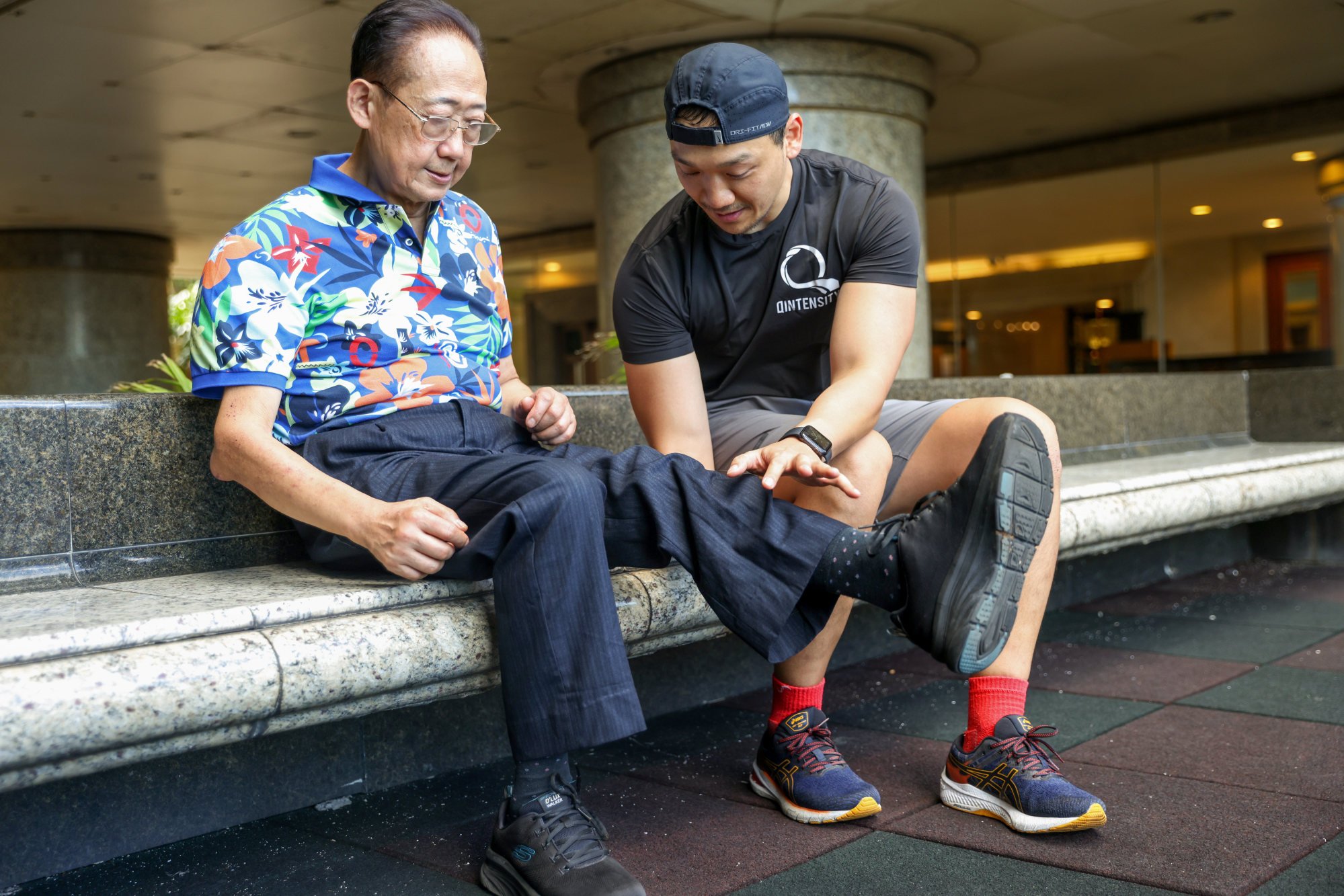From scmp.com
- When long-time osteoarthritis sufferer Franky Chan got a double knee replacement, his mobility was poor and the pain ‘sharp’, so he decided to get moving
- It sounds counterintuitive, but being active has been shown to reduce joint pain, and with the help of his personal trainer, Chan is back and as mobile as ever
Ten years ago, Hongkonger Franky Chan Ming-tsun started to experience problems walking. His legs curved outwards, putting pressure on his knees with every step.
Over time he noticed that he could not stand for long without his knees swelling and his legs feeling like they were about to buckle.
His posture was affected, with his back undergoing tremendous strain as he tried to compensate for the discomfort in his knees.
When the pain got too much to bear, Chan sought medical help. In 2015, he was diagnosed with osteoarthritis – a common condition that causes joints to become painful and stiff.

In January 2022, he underwent double knee replacement surgery that left him with wounds that caused “sharp pains”.
For a month he had to walk with the help of a Zimmer frame but his knees felt “hot” and “uncomfortable”.
We are generally told to avoid physical activity if in pain, but Chan, who is now 67, was keen to exercise following his operation and worked with personal trainer Kyle Liu Kim-man – a joint, pain and movement specialist and co-founder of Qintensity Fitness, in Hong Kong.
Chan was already a client of Liu’s, and a few months before his knee replacement had employed the latter’s services in the hope that exercising would speed up his recovery after surgery.
Liu developed an intervention programme for Chan, focusing on cardiovascular fitness, muscle strengthening, strength building, flexibility, balance and coordination.
The goal of the programme was to slow down muscle loss and enhance Chan’s overall strength and endurance so that he could go about his day free of pain and with little to no risk of falling.

Following surgery, Liu adjusted the programme to help Chan recover faster and increase his muscle strength so that he could start walking again. It included exercises such as seated leg extensions, seated marching, and the “pillow squeeze” – in which one squeezes a pillow between one’s legs to work the inner thighs.
The training sessions took place in Chan’s home.
“I’d never exercised prior to this,” says Chan, whose position as the owner of a jewellery business saw him mostly confined to his desk or crouched over a gemstone-polishing machine.
“My wife suggested I take up exercise before my knee replacement surgery. She exercises regularly and told me how good it makes her feel.”
After his procedure, Chan couldn’t move much because of the pain, but still tried his best to walk using his Zimmer frame, and ride his sitting pedal cycle, which he says allowed him to move his knees without straining them.
Three months later, his knee pain was no longer as intense, and now he can stand and walk for longer periods without needing support or feeling discomfort.
It might seem counterintuitive to exercise when in pain, but research has shown that physical activity can actually help relieve discomfort.
A study published in June 2022 in the journal Arthritis and Rheumatology found that walking for exercise can reduce knee pain among people aged 50 and older who have been diagnosed with knee osteoarthritis, the most common form of arthritis.
It also found that walking for exercise may be an effective treatment to slow the damage that occurs within the joint.
“Being physically active improves our blood circulation, strengthens our muscles, boosts our mood, and enhances our flexibility and mobility,” Liu says.
“These are just a few benefits of exercise, and they all help with pain management as well as allowing the body to move more freely.”
He adds: “One of the main causes of chronic pain is physical inactivity; holding the same posture for a long time without movement can overload our joints and muscles, depending on the area, and increase our risk of developing various pain-related diseases.”
Not everyone who is in pain finds it easy to move; they might even think that physical activity is out of the question, especially if they’ve just had surgery or are injured.
But according to Ally van de Pol, a personal trainer, pain-free performance specialist and head coach at Dragon Fitness and Coaching in Hong Kong, everybody should learn the six human movement patterns – squats, lunges, hinges, pushing, pulling and carrying.
“It’s important that those in pain work with a professional who can help them modify these movements according to their restrictions,” she says.
“Movement should alleviate pain, not add to it.
“For example, if your knees hurt when you squat, I would try to adjust your hip or knee position, perhaps using a box to squat to and using TRX [a suspension training system for Total Resistance Exercises] to support a weaker core and upper body.
“I also often use resistance bands around the knees to support weak hips or behind the knees for Spanish squats.”
Liu advises not to go overboard with exercise if in pain, and that overworking muscles, tendons and ligaments may cause inflammation and worsen the discomfort, and in some cases even tear your ligaments – a problem that requires surgery.
“Very rarely, we also see cases of rhabdomyolysis, when the muscle breaks down from working out excessively without rest. The toxins produced by this breakdown process then travel to the kidneys, where they can cause serious damage.”
For those in pain and wanting to resume physical activity or start an exercise programme, or those who’ve recently had surgery, Liu recommends first seeing a doctor.
With a doctor’s go-ahead, start with a low-impact activity like swimming or walking, gradually increasing the duration and intensity of the exercise as your condition, stamina and fitness improve.
According to Liu, which activity you choose depends on the level of pain you’re experiencing and the pain’s location. If the pain is not too intense, finding the exercise that interests you the most should be a priority because, ultimately, your goal is to build a lifelong exercise habit.
Without regular exercise before and after his surgery, Chan, who has diabetes, believes that his healing “would not have been as thorough” and may have taken longer.
His current workout routine consists of riding his sitting pedal cycle, stretching on a slanted board and on a bed, and walking around 7,000 steps a day.
“If you’ve had knee-replacement surgery like me, it’s important to move, especially during the initial two to three months, even if it’s the last thing you want to do,” he says.
“You need to keep the muscles around your knees flexible, otherwise they will tighten.
“When you start walking again after your surgery, you may not be in that much pain any more but your knees will stiffen up.”
No comments:
Post a Comment